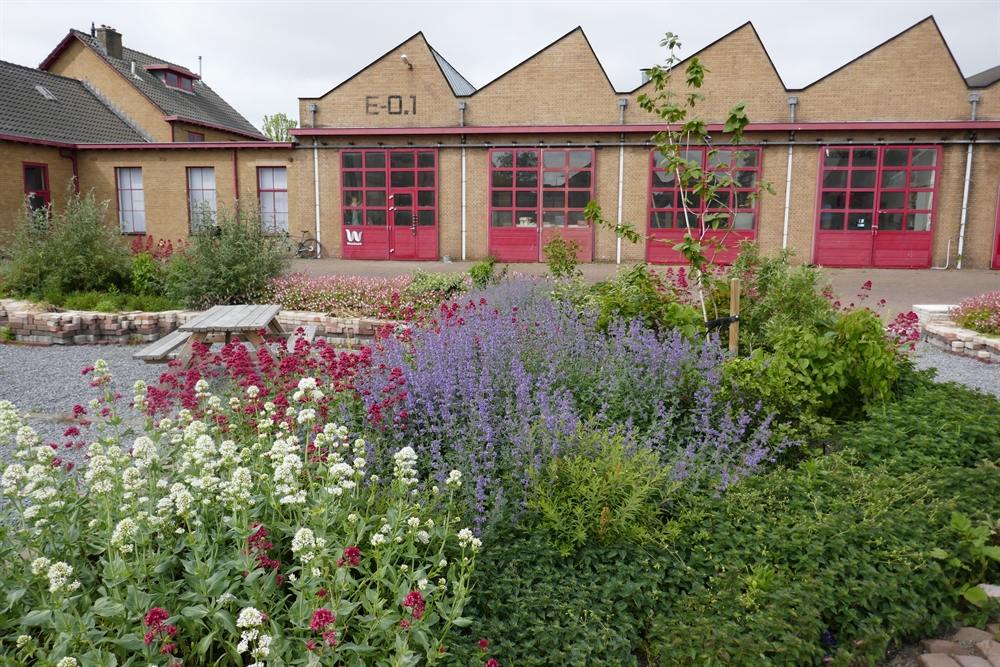9,000 m2 greened at Waarderpolder industrial estate
In 2019, the municipality of Haarlem provided Waarderpolder business park with a greening grant. Subsequently, the Waarderpolder Park Management replaced a total of 9,000 m2 of pavement with greenery, in collaboration with the authorities in charge of public space in the Spaarnelanden region. This additional greenery has added to the climate resilience of the Waarderpolder estate, has enhanced its appeal, and created more room for biodiversity.
What strategy have the Waarderpolder Park Management and the managing body pursued?
First of all, the park authorities and the managing body explored which pavement sections in the area could be converted into green spaces. This posed quite a challenge, as the roads in the industrial estate are narrow. Several roads were bordered by a footpath on both sides. The park authorities and the managing body decided to replace the footpath on one side of the road by greenery. Obviously, such a conversion was only feasible at sections not crossed by driveways, and, moreover, it could not compromise road safety. Via a letter and email, they communicated this plan to the entrepreneurs at the estate. Most of them took a positive stance. Some entrepreneurs feared that the pedestrian routes to and from their businesses would be compromised. The park authorities contacted these entrepreneurs individually, as their support for these measures was vital. In the end, everyone was favourable to the plans and the managing body could embark on the greening work.

Photo: ClimateMatters
Inspired by the ClimateMatters project
For this project, the authorities in charge of the Waarderpolder industrial estate in Haarlem have drawn inspiration from a previous greening project, carried out in 2017–2018, at the MAAK section of the Waarderpolder. In this project, ClimateMatters converted a 300 m2 car park into a small climate park, in collaboration with MAAK entrepreneurs. The project was intended to serve as a model project to enthuse entrepreneurs at the industrial estate into following this example.
Increasing commitment among entrepreneurs
ClimateMatters set up several design sessions with the MAAK entrepreneurs, mainly focused on the urgency of greening: greening as a solution to waterlogging, heat, air pollution, and biodiversity. Increasingly more entrepreneurs wanted to join. Following the preliminary work, the entrepreneurs and the ClimateMatters staff constructed the climate park in three days. At times, no fewer than thirty people were busy simultaneously.
The project was highly successful and garnered increasing commitment among entrepreneurs, some of whom even decided to green their own premises. Responsibility for maintenance of the climate park is vested with the entrepreneurs themselves. Furthermore, the project has raised awareness among the entrepreneurs regarding the wildlife that is attracted by the greenery, which is boosted by the park. For example, they are now hearing more birds sing and seeing more insects. And on National Bees Day, they helped to count bees.
Pioneers are pivotal
In addition to public space, it is also important for private premises to be greened. That is why ClimateMatters, together with the Netherlands Enterprise Agency RVO, organised a meeting with twelve entrepreneurs interested in greening their own premises. The meeting was intended to create an impact through climate-adaptive and biodiverse premises, and to motivate other entrepreneurs to follow suit. Such a pioneering group is essential to expedite the greening of an industrial estate.
Result: boost in climate resilience, biodiversity, and appeal
At the Waarderpolder industrial estate, 9,000 m2 of pavement was removed and seeded with shrubs, herbaceous mixtures, and flower bulbs. The result: rainwater is effortlessly drained into the soil, there is more room for biodiversity, and the public space looks more appealing. The Waarderpolder entrepreneurs are pleased with the green appearance. The park authorities regard the greening of the Waarderpolder as both useful and attractive. The entrepreneurs were enthusiastic and the project was innovative. It has generated positive publicity. And it has resulted in a greener Waarderpolder business park.

Park authorities encouraging entrepreneurs
The park authorities are now also encouraging entrepreneurs to green their own premises. Some have already set to work; others still do not quite see the point of introducing more greenery. True, the benefit of greenery is not always immediately obvious, whereas greenery is definitely adding to the climate resilience of the environment and enhancing biodiversity. Furthermore, the park authorities are considering which other areas in the public space would be appropriate for greening.
Replanting trees via the “Tree Bank”
At the Waarderpolder industrial estate, cutting down trees is subject to an obligation to replant. An entrepreneur who fells a tree, for example, to expand his business, may “buy off” the replanting obligation with the park authorities, whereupon the park authorities will plant a new tree at an appropriate location in the public space. This arrangement is keeping the number of trees in the Waarderpolder area up to par. In the future, the park authorities intend to expand the number of trees in the Waarderpolder area via the Tree Bank.
Lessons to be learned
Any future projects must be carried out in a more sustainable manner. For example, the pavement that was removed went into the grinding mill, whereas many of the paving stones were suitable for reuse. Furthermore, the authorities used tractors with old diesel engines to transport the stones. A Waarderpolder entrepreneur justifiably commented that this was not conducive to achieving the goal of reducing CO2 emissions. In addition to focusing on a sustainable end result, in the future, the Waarderpolder Park Management will also be monitoring the sustainable implementation of the project.
Contact person
Stan Verstraete
Projectleider Verduurzaming Waarderpolder
stan@waarderpolder.nl
